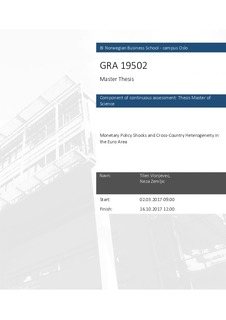Monetary policy shocks and cross-country heterogeneity in the Euro area
Master thesis
Permanent lenke
http://hdl.handle.net/11250/2485080Utgivelsesdato
2017Metadata
Vis full innførselSamlinger
- Master of Science [1621]
Sammendrag
In our thesis, we analyze the transmission of monetary policy in the four largest
Euro area economies, namely Germany, Italy, France and Spain. The focus of the
analysis is to examine the heterogeneity and time variation in response to common
monetary policy shocks for the period spanning from 2004:09-2016:12. For that
purpose, we employ a data-rich environment along with a two-step factoraugmented
vector autoregressive model (FAVAR), introduced by Bernanke,
Boivin, and Eliasz in 2005. Moreover, in order to investigate the time-varying
impacts of the policy effects and the impact of the financial and sovereign debt
crisis on the transmission mechanism, we also use a rolling window technique.
According to our empirical investigation using these methods, the thesis obtains the
following main conclusions:
Firstly, the contractionary impact of the monetary tightening is heterogeneous for a
majority of our measures, i.e. money supply, deposit liabilities and loans, while for
most, the responses appear to be negative. Moreover, the impulse responses of
monetary aggregate M1, deposit liabilities for households and lending for house
purchase to monetary policy shocks are more heterogeneous than that of other key
indicators. Throughout our analysis, we also observe a persistent difference in terms
of heterogeneity between the core and the periphery of the EA. Among the financial
indices, Spanish and Italian are surprisingly the least affected by the monetary
tightening, while overall for our observed measures the responses appear to be the
most homogeneous. Secondly, although the effects of the policy shocks on our
whole sample approach mostly appear to be heterogeneous, we note that over time
the transmission mechanism displays important differences. Namely, our rolling
window estimations imply that the influence of the policy shock on our variables is
rather homogeneous across countries for the period spanning from 2004:09-
2014:07. At the same time, the last two rolling windows, or when moving into the
crisis period, i.e. 2007:09–2015:07 and 2008:09–2016:07, evidently imply more
heterogeneous impact of the shock. We believe that these findings are crucial in
order to further investigate whether or not the Euro area monetary transmission
process is uneven to such extent, that it could complicate the conduct of the single
monetary policy.
Beskrivelse
Masteroppgave(MSc) in Master of Science in Finance - Handelshøyskolen BI, 2017
